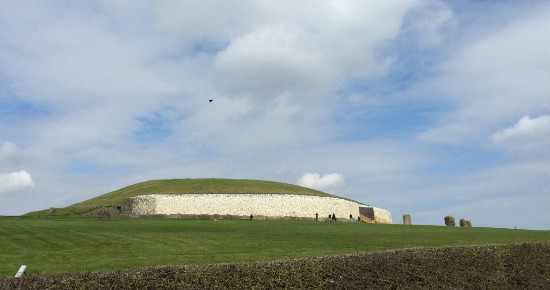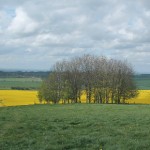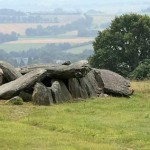I celebrated the coming of spring in four neighboring countries this year. Spring for me began with a Wiccan rite in England. The second rite was at Clonegal Castle in Ireland, the Foundation Centre of the Fellowship of Isis, and then at the Neolithic complexes of Loughcrew, Newgrange, and Knowth.
From Ireland I went by ferry to north Wales and the beautiful mountains of Snowdonia for another celebration. And now I am back home in Brittany, the Celtic north-west of France, reconnecting with the land by mowing the now fast-growing grass, and by clearing away the branches blown off by winter storms from our labyrinth and stone circle. Each place has unique energies and traditions, but in each the signs of spring bring the same messages of hope, renewal, energy, and healing.
My Blood is Green
When I was a child, my affinity with trees was so strong that I used to say that my blood was green. When the sap rose in the tree, my energy rose. I think this is still true for all of us – if we take time to notice. For those of us who teach, going into nature is like drinking at the well of vision. It brings renewal, creativity, and new energy to give to others.
In Wicca there is a saying that, ‘If that which thou seekest thou findest not within thee, thou wilt never find it without thee.’ With each passing year, this seems more and more true. Much of what we are doing as Pagans is re-member-ing, bringing together the fragments of the past to recreate a whole. It is reawakening and recalling knowledge that is already deep within us. It is learning to listen, and to be mindful of what is there within us and around us in the natural world.
The beauty of the seasonal cycle of Paganism is that at each festival we have the opportunity to remind ourselves of the origin of humankind’s spiritual longings and aspirations, which was our wonder of, reverence for, and desire to align ourselves with the mysterious forces of our planet, its environment, and of cosmos beyond. In doing so, we reach out beyond the concerns of the present day to remember that they are but a moment of cosmic time. All will pass, all shall change.
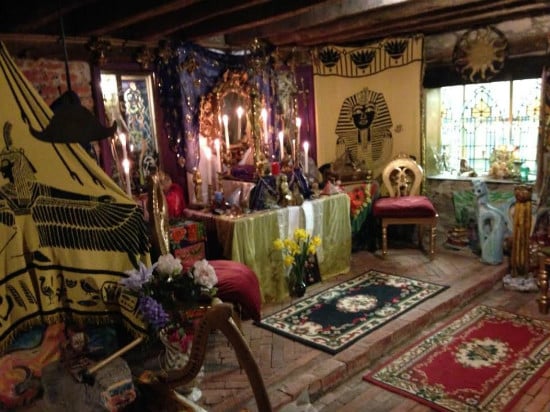
Greening the Spirit
This spring marks the third anniversary of writing this Patheos blog. When I searched in 2013 for a title for the blog, the phrase ‘Greening the Spirit’ came to me. It was spring, so there was a logical connection with what was happening in nature around me. ‘Greening’ is also a stage in the alchemical process and I had been running a workshop on spiritual alchemy the year before.
If you are familiar with Western mysteries kabbalah, you might equate greening to Netzach as it transitions to the gold of Tiphareth. Personal emotions and love begin a journey of transformation into a deeper and wider love that connects us all humankind and to the universe beyond. In yet another esoteric sense, greening is associated with renewal and rebirth, which is why ancient Egyptians depicted the risen Osiris with a green face.
Viriditas
‘Greening’ also appears in the work of one of my favorite women mystics, Hildegard von Bingen (1098-1179). She used the Latin-based word viriditas to express what for her were the essential qualities of the Divine – vitality, fecundity, lushness, verdure, and growth. Writer, artist, prophet, teacher, doctor, and visionary, Hildegard would have been a formable spiritual teacher in any tradition or age.
Her music soars to the heavens and pierces the heart with its beauty and her sense of rapturous wonder at the Divine Feminine. As a woman in Medieval Germany, Hildegard found her spiritual fulfilment in Christianity, but in another era she might have been a priestess of the Goddess and expressed the same love for the Divine made manifest in the natural world.
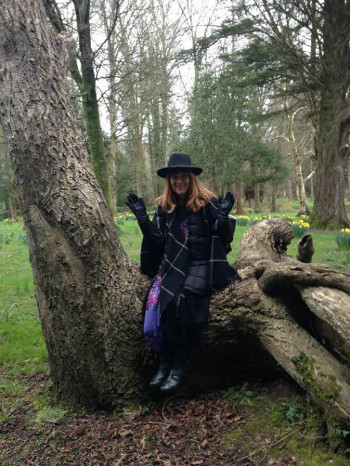
Communing on the Faery Mounds
The word viriditas came to mind this spring as I stood on the green hills of Loughcrew, Co. Meath, Ireland, a Neolithic landscape that is part of the complex of Newgrange and Knowth, a landscape made by nature and remade over 5,000 years ago by human hands. Loughcrew’s more famous sister Newgrange is aligned to the Winter Solstice, but at Loughcrew it is the Spring Equinox dawn that penetrates into the hollow hill to light the burial chamber to signal renewal. Loughcrew is one of those places where the worlds of human and faery draw close. It is as though unseen presences are just out of sight behind the tree-lined pathway that leads up to the top of the mounds.
The air is filled with intense sound, the sound of birds singing. And as we listen to birdsong it is easy to slip back into the past, to see our ancestors winding towards the hills to reach the goal of their pilgrimage. All over the world human beings created sacred places where communities could gather to honor shared symbols and values; to draw close to the Gods and to one another. One important aspect of contemporary Paganism has been to recreate such gatherings; to gather for community festivals that celebrate our way of life and our values, and to meet with others from far away who share them with us.
Communitas
Connecting with others on our spiritual path can be challenging, but building a sense of communitas, community with others, is just as important as communing with nature. Many Pagans worship alone much of the time, but social interconnection is one of the driving forces of human behavior. In Ireland, at Loughcrew, Newgrange and Knowth, we see a 5,000 year legacy of extraordinary human collective efforts that involved moving thousands upon thousands of tons of earth and stone; efforts that would have taken centuries to complete. At one time, the pyramids of Egypt were thought to be the oldest human-made structures, but each decade brings new archeological discoveries. We know now that Europe’s megalithic structures are older.
Where I live In Brittany in north-west France, we have a burial chamber that is 7,000 years old. In eastern Turkey there are sacred sites that appear to be 12,000 years old or more. Each decade’s archeological discoveries take the time line back a little further. And these sophisticated structures made with only hand tools of stone and wood are only the more recent flowerings of a human urge to create sacred space that extends back to our earliest origins.
When we go to an ancient site, we sense something of the mystery and wonder that drove ancient peoples to create it. Even if they are not ancestors related to us by blood and bone, we sense a spiritual continuity with them. We feel an empathy for what they were striving to achieve and we are grateful that they have left these symbols of faith and reverence for us their heirs. They are a powerful reminder, when creating a Paganism for a post-Christian age seems difficult, when we falter at the enormity of the Great Work. Our ancestors’ vision extended centuries ahead, working to build something they would never fully enjoy. Each contribution that we make is like another stone on the cairn, another bucket of earth on the mound, we build slowly but step-by-step we build.

